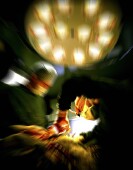
TUESDAY, July 8, 2014 (HealthDay News) — Less aggressive treatment will likely lead to better outcomes for people having their gallbladders removed, according to a pair of new studies.
One study found that people with gallstones do better if doctors just remove their gallbladder, instead of first snaking a scope inside to assess the medical problem.
“They were able to show that patients in this group did just as well without testing prior to having their gallbladder taken out,” said Dr. Joseph Solomkin, a surgeon at the University of Cincinnati College of Medicine who wrote an editorial accompanying the studies published July 9 in the Journal of the American Medical Association.
The other study found that doctors can skip ordering antibiotic treatment after gallbladder surgery without increasing patients’ risk of infection.
“They showed that post-surgical antibiotics simply aren’t necessary, that one dose prior to surgery is all that’s needed,” Solomkin said.
The gallbladder is a pear-shaped organ located under the liver that stores bile, a fluid secreted by the liver that helps break down fat. As the stomach and intestines digest food, the gallbladder releases bile into the digestive tract through a tube called the common bile duct.
Unfortunately, the bile inside the gallbladder may harden to form gallstones. These stones can block the bile ducts, causing illness and infection.
People can live without their gallbladder, as bile can find other ways to get to the intestines, so surgery has become a safe and routine way of treating gallstones, Solomkin said.
“It’s probably the most common procedure we do. It’s extremely frequent,” he said. “It’s done laparoscopically [a minimally invasive surgical technique], and a lot of people go home either that night or the next morning.”
Doctors often perform an endoscopy prior to gallbladder removal for high-risk patients, but there are no guidelines for whether they should scope moderate-risk patients before surgery, authors of the first study said in background material.
For this study, Swiss researchers randomly assigned 100 moderate-risk patients with possible gallstones to either go straight to gallbladder removal, or to be scoped first, followed by surgery.
The investigators found that the half who went straight to surgery had shorter hospital stays, with a median of 5 days compared with 8 days for those who underwent scoping in advance. There was no significant difference in illness or quality of life between the two groups.
Skipping the endoscopy also could save money, given that people stayed a shorter period of time in the hospital while not undergoing an additional procedure, the authors said.
In the second study, French researchers focused on just over 400 people who had acute calculous cholecystitis, an inflammation and enlargement of the gallbladder. About one-fifth of the gallbladder removals performed each year in the United States are prompted by this illness, the researchers said in background information.
Many patients receive a round of antibiotics following gallbladder removal for this illness because of concerns that the inflamed organ has caused an infection, researchers said.
To see whether the antibiotics are necessary, half of the patients in the study received the regular course of post-surgical antibiotics while the other half received antibiotics only prior to surgery.
Doctors found that infection rates between the two groups were similar, 17 percent in those who didn’t receive antibiotics after surgery compared with 15 percent in those who did. Both groups had similar hospital stays and readmission rates.
There were no infection-causing bacteria at all in three-fifths of the cases, noted study lead author Dr. Jean Marc Regimbeau. He speculated that the remaining 40 percent of patients were aided by removal of the infected organ.
“The surgical procedure acts like a drainage of an abscess and enables a decrease of the bacterial count,” said Regimbeau, a surgeon at Amiens University Medical Center in Amiens, France.
More information
For more about gallbladder diseases, visit the U.S. National Library of Medicine.
Copyright © 2025 HealthDay. All rights reserved.

